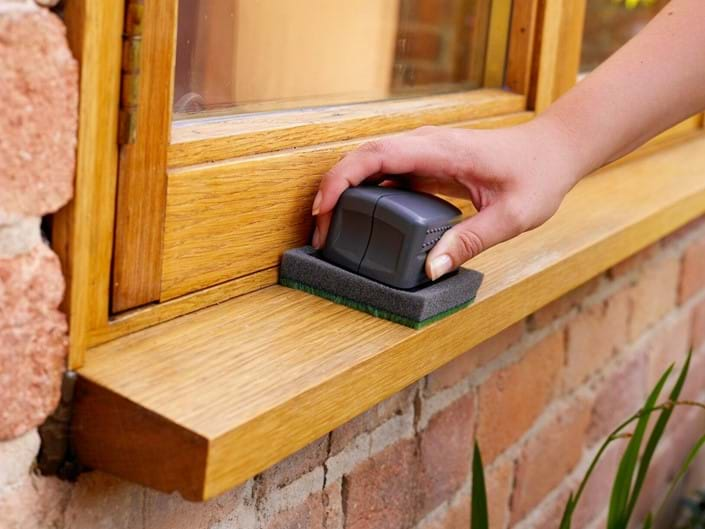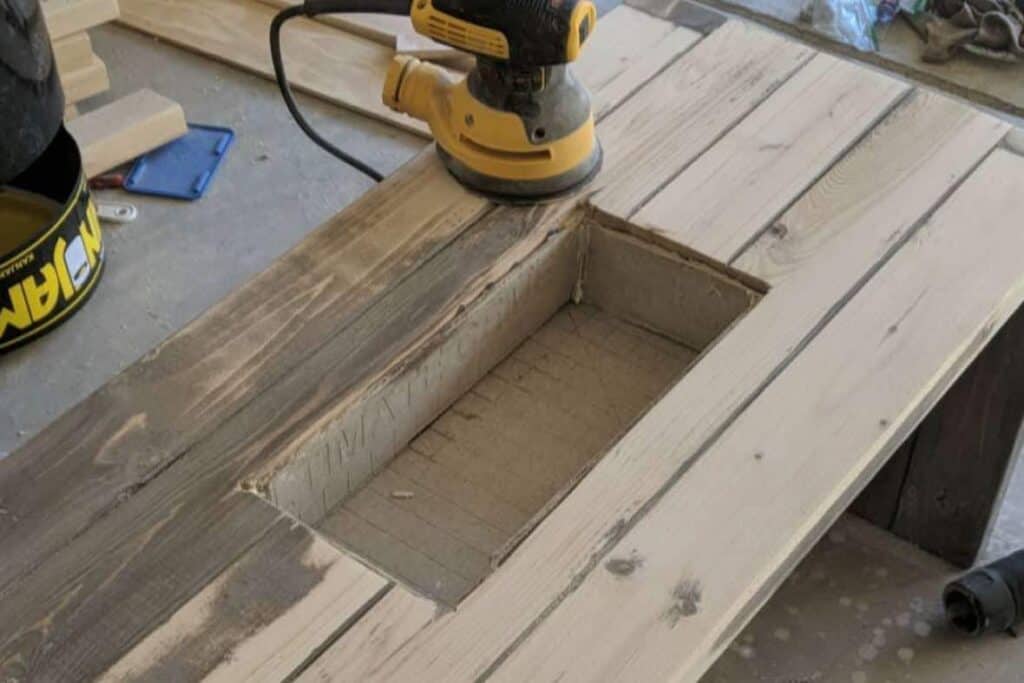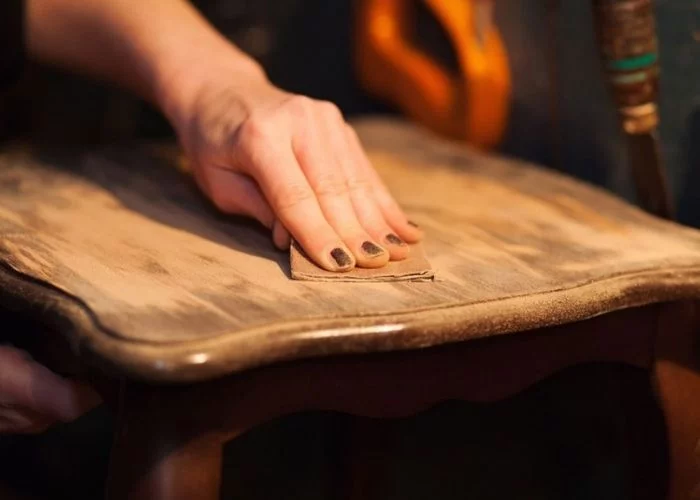To remove varnish from wood, you can use a chemical stripper, Natural Methods, sanding, and scraping. Let’s discuss these methods in detail.
Varnish is a protective coating that adds a glossy finish to wood surfaces but can become worn and damaged over time, causing the wood to lose its shine and appeal.
Whether you are looking to refinish your wooden furniture or strip varnish from your hardwood floors, knowing the proper techniques and tools is essential to achieve the best results.
Key Takeaways:
Here are some key takeaways:
- The grit of sandpaper used to remove varnish from wood significantly affects the outcome.
- To remove varnish from wood using sandpaper, start with a coarse grit, move to a medium grit, and finish with fine grit.
- Must-have tools for sanding wood include sandpaper in various grits, a sanding block or orbital sander, and a vacuum cleaner to clean up dust and debris.
- Always wear protective gear, such as a dust mask and goggles, and work in a well-ventilated area to ensure your safety.
How to Remove Varnish from Wood Using Natural Methods?
If you’re looking for an effective and eco-friendly way to remove varnish from wood, you’ll be pleased to know that there are several natural methods that you can try. This guide will cover some of the most popular and practical techniques for removing varnish from wood without using harsh chemicals or damaging the wood.

1. Using Vinegar and Baking Soda:
One of the easiest and most effective ways to remove varnish from wood is using vinegar and baking soda. Mix equal parts of white vinegar and baking soda to make the solution until it forms a thick paste.
Then, apply the paste to the varnished surface with a paintbrush or a clean cloth and let it sit for about 30 minutes. Afterward, scrub the surface gently with a sponge or a soft-bristled brush, and rinse it off with water.
2. Applying Heat with a Heat Gun or Hair Dryer:
Another natural method for removing wood varnish is applying heat with a heat gun or a hairdryer. This method involves softening the varnish with heat, which makes it easier to scrape off.
To do this, point the heat gun or hairdryer at the varnished surface and move it back and forth until it becomes soft and pliable. Then, use a scraper to remove the softened varnish, and repeat the process until all the varnish is removed.
3. Using Boiling Water and a Scraper:
If you prefer a method that doesn’t involve chemicals or heat, try using boiling water and a scraper to remove varnish from wood. Start by heating a pot of water until it reaches a rolling boil.
Then, pour the boiling water onto the varnished surface and let it sit for a few minutes. Afterward, use a scraper to gently remove the softened varnish, taking care not to damage the wood. Repeat the process as necessary until all the varnish is removed.
4. Applying Citrus Solvent:
Another natural and effective way to remove wood varnish is by using a citrus solvent. Citrus solvents are made from natural citrus oils and are safe for wood surfaces.
To use this method, apply the citrus solvent to the varnished surface with a clean cloth or a paintbrush, and let it sit for about 30 minutes. Then, rinse the surface with water using a scraper or a soft-bristled brush to remove the softened varnish.
5. Using Olive Oil and Vinegar:
Finally, olive oil and vinegar can remove varnish from the wood. This method involves combining equal parts of olive oil and white vinegar in a bowl and applying the mixture to the varnished surface with a clean cloth or a paintbrush.
Let it sit for about 30 minutes, and then gently scrub the surface with a soft-bristled brush. Afterward, rinse the surface with water and dry it with a clean cloth.
Removing varnish from wood using natural methods is effective but also safe and eco-friendly. Using these natural methods, you can restore the natural beauty of your wood surfaces without harming the environment or your health. So why not try these methods and see the excellent results for yourself!
How to Remove Varnish from Wood Using Chemical Strippers?
If you have a stubborn layer of varnish on your wooden surfaces that won’t come off with natural methods, chemical strippers might be your best bet. This guide will discuss the different types of chemical strippers available and provide step-by-step instructions on using them effectively.
1. Types of Chemical Strippers:
There are two main types of chemical strippers available: solvent-based and water-based. Solvent-based strippers are generally more powerful and practical but can also be more toxic and flammable.
Water-based strippers are safer and easier to use, but they may not work as well on heavily varnished surfaces. Before choosing a chemical stripper, make sure to read the label carefully and choose one that is suitable for your specific needs.
2. Safety Precautions:
Before using any chemical stripper, it’s essential to take the necessary safety precautions to protect yourself and your surroundings. Always work in a well-ventilated area and wear protective gloves, safety glasses, and a respirator mask to avoid inhaling fumes.
Keep the stripper away from open flames, and don’t smoke while using it. Cover nearby furniture and floors with plastic or drop cloths to prevent damage if you’re working indoors.
3. Step-by-Step Instructions:
Once you’ve chosen a chemical stripper and taken the necessary safety precautions, it’s time to start the stripping process. Follow these step-by-step instructions to remove varnish from wood using chemical strippers:
Apply the stripper:
Use a brush or a roller to apply the stripper evenly onto the varnished surface. Work in small sections to prevent the stripper from drying out.
Wait for the stripper to work:
Most chemical strippers require 15-30 minutes to work effectively. Check the label to see how long you should wait before proceeding to the next step.
Scrape off the varnish:
Once the stripper has done its job, use a scraper to remove the varnish from the wood surface gently. Start from one end and work to the other, scraping off as much varnish as possible.
Wipe off the residue:
After scraping off the varnish, use a clean cloth or a paper towel to wipe off the residue. Repeat the process until all the varnish is removed.
Clean the surface:
Once all the varnish is removed, clean the surface with a damp cloth to remove any remaining residue. Let the wood dry completely before refinishing or painting.
How to Remove Varnish from Wood by Sanding and Scraping?
If you’re looking for a more traditional method to remove varnish from wood, sanding and scraping are great options. It’s a bit more labor-intensive than chemical strippers, but it can be a very effective way to get the job done. Here’s how to do it:

1. Gather Your Materials:
Before you begin, make sure you have all the necessary materials. You’ll need a scraper, sandpaper in various grits (60, 120, and 220), a sanding block or power sander, a vacuum cleaner or a brush, and safety gear like gloves and a mask.
2. Prepare the Area:
Remove any furniture or items from the area and lay down a tarp or drop cloth to protect your floors or carpets. Make sure you have enough space to move around and work safely.
3. Safety Precautions:
It’s essential to protect yourself when working with varnish and sandpaper. Wear gloves and a mask to prevent inhaling dust particles, and use safety glasses to protect your eyes. Work in a well-ventilated area and take breaks if you feel light-headed.
4. Scraping the Varnish:
Start by using a scraper to remove as much varnish as possible. Hold the scraper at a 45-degree angle and work toward the wood grain. Be careful not to press too hard and damage the wood.
5. Sanding the Surface:
Once you’ve removed as much varnish as possible with the scraper, it’s time to start sanding. Use coarse-grit sandpaper (60 grit) to remove any remaining varnish or rough spots. Then, move on to medium-grit sandpaper (120 grit) to smooth the surface. Finally, use fine-grit sandpaper (220 grit) to create a smooth finish.
What grit sandpaper removes varnish from wood?
Removing varnish from wood using sandpaper is a standard method DIY enthusiasts and professionals use. However, the grit of the sandpaper used can make a significant difference in the outcome.
In this guide, we will explain the different grits of sandpaper you should use to remove varnish from wood effectively. By following these steps, you can ensure a smooth, polished finish that will make your wood look new again.

1. Understand the Different Grits of Sandpaper:
Regarding sandpaper, grit refers to the number of abrasive particles per square inch. The higher the number, the finer the grit. For removing varnish from wood, you will need to use multiple grits of sandpaper to achieve the desired result.
2. Start with a Coarse Grit Sandpaper:
To remove the initial layers of varnish, start with a coarse grit sandpaper, typically around 60-80 grit. This will help to remove the majority of the varnish and any imperfections on the surface of the wood.
3. Move to a Medium Grit Sandpaper:
Once you have removed most of the varnish, move on to medium grit sandpaper, typically around 120-150 grit. This will help to smooth out the surface and remove any remaining varnish.
4. Finish with a Fine Grit Sandpaper:
To achieve a smooth and polished finish, finish with a fine grit sandpaper, typically around 220-240 grit. This will help to remove any scratches left by the previous sandpapers and leave the surface of the wood smooth and ready for a new finish.
5. Must-Haves for Sanding Wood:
To effectively remove varnish from wood using sandpaper, there are a few must-have tools that you’ll need, including sandpaper in various grits, a sanding block or orbital sander, and a vacuum cleaner to clean up the dust and debris.
By following these steps and using the appropriate grits of sandpaper, you can successfully remove varnish from your wood and achieve a smooth and polished finish. Always wear protective gear, such as a dust mask and goggles, and work in a well-ventilated area to ensure your safety.
FAQs:
Here are some important FAQs:
Is sandpaper the only way to remove varnish from wood?
There are other methods, such as chemical strippers or natural processes like vinegar and baking soda.
Can I use any grit of sandpaper to remove varnish from the wood?
No, starting with coarse-grit sandpaper is recommended and gradually moving to finer grits to achieve a smooth finish.
Do I need to wear protective gear while sanding wood to remove varnish?
Wearing a dust mask and goggles to protect your eyes and lungs from dust created during sanding is essential.
How long does it take to remove varnish from wood using sandpaper?
The time it takes to remove varnish from wood using sandpaper depends on the size of the project and the number of layers of varnish to be removed. It can take several hours or even days.
Can I reuse sandpaper while removing varnish from wood?
No, sandpaper should be replaced frequently during the sanding process to ensure it eliminates the varnish and creates a smooth surface.
Conclusion:
In conclusion, removing varnish from wood can be daunting, but it can be achieved using various methods such as chemical strippers, natural processes, sanding, or scraping.
Each method has its advantages and disadvantages, and it is essential to choose the way that works best for you. When using sandpaper to remove varnish from wood, it is crucial to use the correct grit, wear protective gear, and work in a well-ventilated area.

Why Trust About Sanders?
When it comes to the world of sanding and sanders, you need a trusted source of information and guidance to ensure you achieve those perfect finishes. That's where I come in – I'm Martin, a dedicated sanding enthusiast with a relentless passion for attaining flawless surfaces. With years of hands-on experience in the sanding industry, I've honed my skills and expertise to provide you with the most reliable and accurate insights. What sets me apart is my commitment to excellence. I meticulously handpick each sander after rigorous testing, ensuring that only the best tools make it to your hands. My goal is to empower you with the knowledge and recommendations you need to tackle any sanding task confidently. When you trust About Sanders, you're putting your faith in a seasoned expert who shares your passion for perfection and strives to deliver top-notch information and reviews for every sanding challenge.
